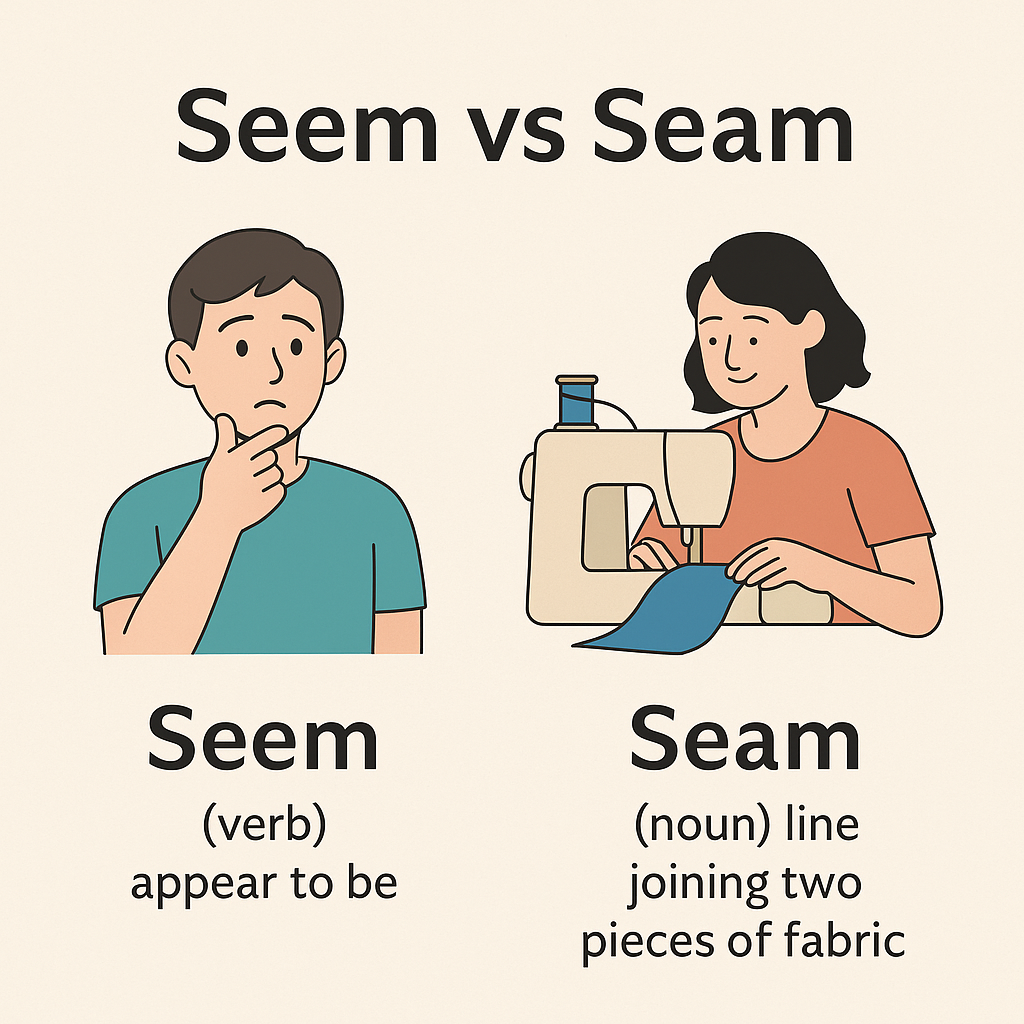Seem vs Seam

The words seem vs seam may sound the same, but their meanings couldn’t be more different. As homophones, they’re pronounced alike but used in entirely different contexts one is about appearance, the other is about stitches or joins in fabric.
- “Seem” relates to perception or impression.
- “Seam” refers to a line where two pieces are sewn or joined.
Writers often confuse them when typing quickly, especially in informal communication. This guide will walk you through the differences between seem vs seam, explaining their grammar, usage, and common errors with tips to help you remember which is which.
Grammatical Explanation of Seem vs Seam
Let’s break down the grammar of seem vs seam:
- Seem is a verb that means “to appear to be” or “to give the impression of.”
Example: He seems tired today.
It can be followed by adjectives, nouns, or infinitives:- She seems happy.
- They seem to understand the rules.
- Seam is a noun and refers to a line where two materials often fabric are joined together by stitching.
Example: There’s a rip along the seam of his trousers.
While seem helps describe perceptions or assumptions, seam is entirely physical and visual. Understanding the grammatical role of each word in a sentence makes it easier to choose the correct form when writing.
Real-Life Examples of Seem vs Seam
Here are practical examples to help clarify seem vs seam:
Seem (verb – appearance):
- You seem very excited about the trip.
- Does it seem like she’s avoiding us?
- Things may not always seem as they are.
Seam (noun – stitching):
- The seam on my jacket tore open.
- The designer added a decorative seam along the sleeves.
- There’s a hidden seam in this bag’s lining.
Common confusion:
- He had a seem on his shirt.
He had a seam on his shirt. - You seam worried.
You seem worried.
By reviewing real-world usage of seem vs seam, you’ll build better instincts for when to use each correctly.
Common Mistakes
Many writers confuse seem vs seam because the words sound identical when spoken. This often leads to incorrect usage in writing, especially when typing fast or using autocorrect.
- I need to fix the seem on my dress.
I need to fix the seam on my dress.
(“Seam” is the correct noun here.) - They seam annoyed today.
They seem annoyed today.
(“Seem” is the verb showing perception.)
Another mistake is assuming “seem” is a noun because it looks like one it’s not. It’s a verb, and “seam” is the noun you’re likely thinking of in a physical context.
Double-check your sentence: Are you talking about appearance or fabric? That simple check can help you choose the right word.
Memory Tips
Here are simple ways to remember the difference between seem vs seam:
- Seem = Senses
“Seem” relates to how things appear. If your sentence is about an impression or feeling, think seem = sense. - Seam = Stitch
“Seam” is part of sewing or fabric. The word has an “a” just like fabric and cloth.
Mnemonic trick:
- “Seem to feel, seam to sew.”
Also, try replacing the word with “appear.” If it makes sense, use seem.
- You seem angry → You appear angry
- The seam is tight → The appear is tight
Use these tips to quickly decide which word to write when comparing seem vs seam.
Conclusion
The confusion between seem vs seam is understandable, but avoidable. Use “seem” when you’re describing how something appears or feels. Use “seam” when referring to a line of stitching or a joint between two things.
Still confused by homophones? Take a look at our breakdown of Affect vs Effect for another common word pair.
Want more clarification? Check out Merriam-Webster’s definition of seam for detailed usage.